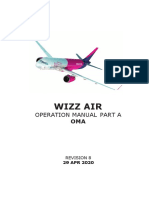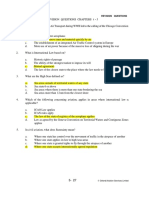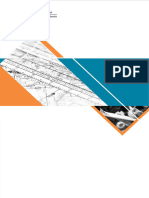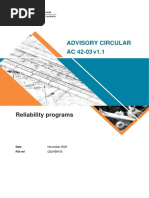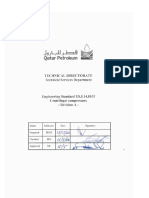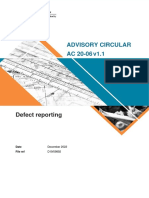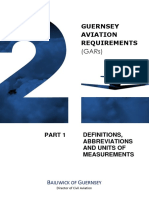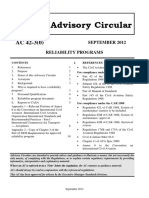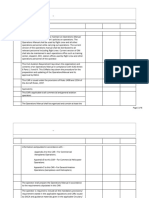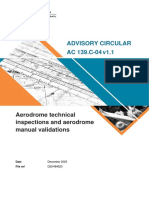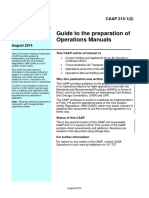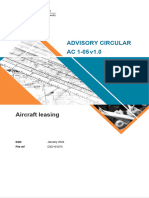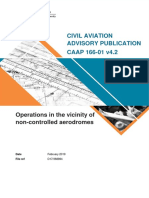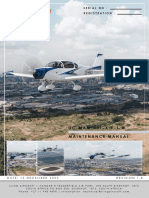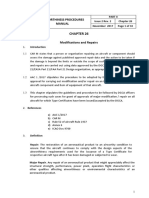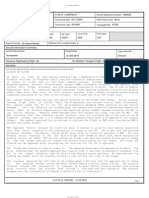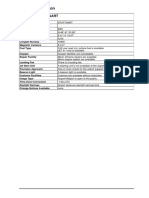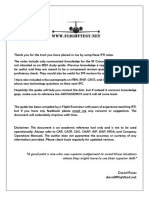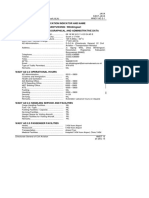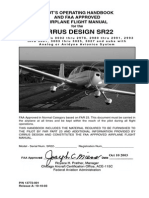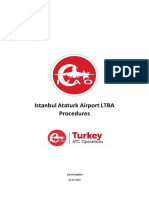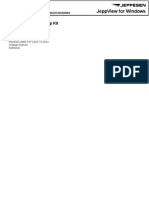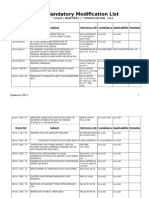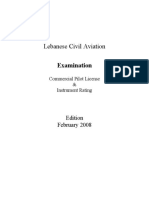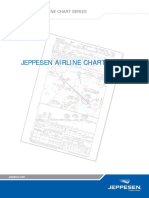Caap 43 01 Maintenance Release
Caap 43 01 Maintenance Release
Uploaded by
shishobCopyright:
Available Formats
Caap 43 01 Maintenance Release
Caap 43 01 Maintenance Release
Uploaded by
shishobOriginal Title
Copyright
Available Formats
Share this document
Did you find this document useful?
Is this content inappropriate?
Copyright:
Available Formats
Caap 43 01 Maintenance Release
Caap 43 01 Maintenance Release
Uploaded by
shishobCopyright:
Available Formats
CIVIL AVIATION
ADVISORY PUBLICATION
CAAP 43-01 v2.0
Maintenance release
Date November 2018
File ref D17/380765
v2.0 – November 2018
MAINTENANCE RELEASE
This Civil Aviation Advisory Publication (CAAP) provides guidance, interpretation and explanation on complying with
the Civil Aviation Regulations 1988 (CAR) or a Civil Aviation Order (CAO).
This CAAP provides advisory information to the aviation industry in support of a particular CAR or CAO. Ordinarily, the
CAAP will provide additional ‘how to’ information not found in the source CAR, or elsewhere.
CAAPs should always be read in conjunction with the relevant regulations/orders.
Audience
This CAAP applies to:
• licensed aircraft maintenance engineers (LAMEs)
• certificate of approval holders (in accordance with regulation 30 of CAR)
• registered operators
• pilots-in-command.
Purpose
The purpose of this CAAP is to describe a method of complying with the directions specified in the
CAR for the issue and use of aircraft maintenance releases and specifically the use of the CASA
Form 918.
For further information
For further information on this CAAP, contact CASA’s Airworthiness and Engineering Branch
(telephone 131 757).
CAAP 43-01 v2.0 November 2018 Page 1
MAINTENANCE RELEASE
Status
This version of the CAAP is approved by the Manager, Airworthiness and Engineering Branch.
Note: Due to the scope of changes made in the current version, amendments are not annotated. The document
should be read in full.
Version Date Details
v2.0 November This version of CAAP 43-1 is a complete rewrite to:
2018 • reflect changes to CAO 100.5, which now sets out a direction under
regulation 43 of CAR for use of the CASA maintenance release
• clarify the requirements for making or clearing an endorsement on Part 2
of a maintenance release for defects that are not a major defect
• explain the requirements relating to issuing of the CASA maintenance
release outside of Australian Territory
• explain the requirements for the issuing of a maintenance release for an
aeroplane engaged in an aerial application conducted at night if the
aeroplane is not equipped and certificated for night visual flight rules flight
under Part 21 of the Civil Aviation Safety Regulations 1998 (CASR)
• describe the use of supplementary pages to extend Parts 1, 2 or 3 of the
CASA maintenance release (if required for repetitive entries).
(1) August 1997 This is the second issue of CAAP 43-1. It has been amended by deletion of
one paragraph to remove reference to the pilot-in-command issuing and
signing a maintenance release outside Australian territory under an instrument
of appointment. The procedure has never been utilised or authorised and may
cause confusion.
(0) March 1992 This is the first issue of CAAP 43-1, and will remain current until withdrawn or
superseded.
CAAP 43-01 v2.0 November 2018 Page 2
MAINTENANCE RELEASE
Contents
1 Reference material 4
1.1 Acronyms 4
1.2 Definitions 4
1.3 References 5
1.4 Forms 6
2 Background 7
2.1 General requirements 7
2.2 Validity period 8
3 Part 1 of the maintenance release 9
3.1 Information 9
3.2 Maintenance required 10
4 Part 2 of the maintenance release 12
4.1 Dealing with required maintenance 12
4.2 Dealing with defects 12
5 Part 3 of maintenance release 14
5.1 Daily inspection 14
5.2 Flight time 14
5.3 Supplementary pages 15
6 Issuing a maintenance release outside of Australian territory 16
6.1 Class A aircraft 16
6.2 Class B aircraft 16
7 Operator considerations 17
7.1 Use of supplementary pages 17
7.2 Retention of maintenance releases and copies 17
Annex A - Supplementary page - Part 1
Annex B - Supplementary page - Part 2
Annex C - Supplementary page - Part 3
CAAP 43-01 v2.0 November 2018 Page 3
MAINTENANCE RELEASE
1 Reference material
1.1 Acronyms
The acronyms and abbreviations used in this CAAP are listed in the table below.
Acronym Description
CAAP Civil Aviation Advisory Publication
CAR Civil Aviation Regulations 1988
CASA Civil Aviation Safety Authority
CASR Civil Aviation Safety Regulations 1998
CAO Civil Aviation Order
COA certificates of approval
COR certificate of registration
IFR instrument flight rules
MEL minimum equipment list
SOM system of maintenance
TIS time-in-service
VFR visual flight rules
1.2 Definitions
Terms that have specific meaning within this CAAP are defined in the table below.
Term Definition
Class A aircraft An Australian aircraft, other than a balloon, that satisfies either or both of the
following paragraphs:
a. the aircraft is certificated as a transport category aircraft;
b. the aircraft is being used, or is to be used, by the holder of an Air
Operator’s Certificate which authorises the use of that aircraft for
the commercial purpose referred to in paragraph 206 (1) (c).
Class B aircraft An Australian aircraft that is not a class A aircraft.
Contracting state A foreign country that is a party to the Chicago Convention.
Flight time The time the aircraft is in service, which is defined as the elapsed time that
commences when the aircraft first takes off for a flight and finishes when it
lands at the end of the flight.
CAAP 43-01 v2.0 November 2018 Page 4
MAINTENANCE RELEASE
Term Definition
Major defect A major defect is described in regulation 51A as a defect:
a. that has caused, or that could cause, a primary structural failure in
an aircraft; or
b. that has caused, or that could cause, a control system failure in an
aircraft; or
c. that has caused, or that could cause, an engine structural failure in
an aircraft; or
d. caused by, that has caused, or that could cause, fire in an aircraft.
42A Manufacturers A schedule issued by the manufacturer of the aircraft that sets out what
maintenance schedule (in maintenance should be carried out on the aircraft and when it should be
relation to an aircraft) carried out.
1.3 References
Regulations
Regulations are available on the Federal Register of Legislation https://www.legislation.gov.au/
Document Title
Schedule 5 of CAR CASA Maintenance Schedule
Schedule 6 of CAR CASA System of certification of completion of maintenance
Regulation 37 of CAR Permissible unserviceabilities
Division 9 of Part 4A of CAR Maintenance releases
Regulation 133 of CAR Conditions to be met before Australian aircraft may fly
Regulation 139 of CAR Documents to be carried in Australian aircraft
Regulation 174A of CAR Equipment of aircraft for VFR flight
Regulation 177 of CAR Equipment of aircraft for IFR flight
Regulation 248 of CAR Reporting of defects
CAO 20.18 Aircraft equipment - basic operational requirements Instrument 2014
CAO 100.5 General requirements in respect of maintenance of Australian aircraft
2011
CASA instrument 147/11 Appointment of authorised persons to issue maintenance releases
CASA instrument 148/11 Appointment of authorised persons to endorse or cancel
endorsements on maintenance releases
CAAP 43-01 v2.0 November 2018 Page 5
MAINTENANCE RELEASE
Advisory material
CASA's Civil Aviation Advisory Publications are available at http://www.casa.gov.au/CAAP
Document Title
CAAP 50A/B-1 Aircraft Log Books and Alternate to Aircraft Log Books
CAAP 41-2 Maintenance requirements for Class B aircraft
CAAP 42ZV-1 Maintenance Control Manual
1.4 Forms
CASA’s forms are available at http://www.casa.gov.au/forms
Form number Title
Form 918 Maintenance release (flight & tech)
Form 918A Aircraft log book
Form DA741 Superseded maintenance release form
CAAP 43-01 v2.0 November 2018 Page 6
MAINTENANCE RELEASE
2 Background
The maintenance release is central to safe operation of aircraft that are not maintained
under Part 42 of the Civil Aviation Safety Regulations 1998 (CASR). It provides
certificate of registration (COR) holders, and pilots with evidence that an aircraft has
had the required maintenance carried out, provides details of any defects that may
require rectification before a flight can commence and also provides essential
information about any scheduled maintenance actions that may become due before
completion of a planned flight.
The maintenance release also provides a maintainer with a record of deferred defects
and other maintenance actions that require attention during both unscheduled and
scheduled maintenance. The maintenance release also provides a certification record
for the purpose of recording maintenance that has been completed during the life of the
maintenance release.
In order to ensure that the maintenance release is properly used, it is important that
COR holders, pilots and maintainers understand the instructions for use of the
document and properly follow them.
Instructions for the use of the CASA Form 918 are published as Appendix 3 to Civil
Aviation Order (CAO) 100.5 and a summary of those instructions is provided inside the
front cover of the CASA maintenance release book.
Note: The Appendix 3 instructions also apply to persons who continue to use their stocks of the
superseded Form DA741.
2.1 General requirements
2.1.1 Paragraph 139 (1) (c) of the Civil Aviation Regulations 1988 (CAR) directs that an
aircraft shall not commence flight unless there is a valid maintenance release or other
approved document in force, covering the period of that proposed flight. This is to
ensure that the pilot-in-command:
− is informed of any defects in the aircraft
− is able to determine that all required maintenance on the aircraft has been
completed and certified
− can determine that no maintenance requirement will become due during the time of
the proposed flight.
2.1.2 A new maintenance release is required to be issued by a person who is authorised by
CASA for the purpose of sub regulation 43 (1) of CAR, using the CASA Form 918 or an
approved alternative, at the completion of the required maintenance release inspection.
2.1.3 Authorised persons for the issue of a maintenance release in Australian territory are the
holders of certificates of approval (COA) issued under regulation 30 of CAR for the
maintenance of aircraft, subject to those aircraft being covered by their certificates. The
person signing the maintenance release is doing so on behalf of that COA holder.
2.1.4 The instructions for the issue and use of the maintenance release, contained in
Appendix 3 of CAO 100.5 are a direction made under subregulation 43 (1) of CAR and
CAAP 43-01 v2.0 November 2018 Page 7
MAINTENANCE RELEASE
must be complied with. If an alternate maintenance release has been approved by
CASA, then the instructions for use of that maintenance release must be complied with.
2.1.5 The approved maintenance release for Class B aircraft is CASA Form 918 or DA741.
Alternative maintenance releases and maintenance release issue procedures may be
used but they must be approved by CASA. Guidance for the format and content of an
alternative maintenance release may be obtained from any CASA office.
2.1.6 The identity of the maintenance release inspection will be found in the aircraft's log
book statement-Part 1 or the aircrafts system of maintenance (SOM) / maintenance
control manual. If a COR holder has nominated the CASA Maintenance Schedule
(Schedule 5) for the aircraft, the maintenance release inspection is required to be
carried out at the periods specified in Part 2 of Schedule 5. This inspection must be
performed by the holder of an appropriate certificate of approval to perform the
maintenance.
2.1.7 CASA Instrument 147/11 specifies that a maintenance release must be signed prior to
its issue by one of the following:
− the person certifying for co-ordinating the maintenance release inspection
− where all required inspection certifications have been made by one person, that
person
− an employee who is the holder of an appropriate aircraft maintenance engineer
licence, an airworthiness authority or an authorisation issued under regulation
42ZC and is authorised to issue the maintenance release on behalf of a COA
holder.
2.1.8 A maintenance release will be issued for:
− the time in service (TIS) or calendar period specified in the log book statement
Part 1 for the aircraft, whichever is the earlier; or
− the periods specified in the operator's approved SOM or maintenance control
manual as applicable.
2.1.9 When using alternative maintenance records to the CASA aircraft log book, the
maintenance release will be issued for the TIS specified in the operator's approved
alternative records, SOM or maintenance control manual.
2.2 Validity period
2.2.1 A maintenance release ceases to be in force when any of the following occurs:
− an endorsement under regulation 47 of CAR has been made on Part 2 of the
maintenance release stating that the aircraft is not airworthy
− the expiry date or aircraft total time-in-service specified on the maintenance release
has been reached
− the inspection for the issue of a new maintenance release has commenced
− any required maintenance specified in Part 1 of the maintenance release has not
been completed
− any maintenance required to be carried out by an airworthiness directive (AD) or a
direction under regulation 38 of CAR has not been completed in accordance with
the direction or AD.
CAAP 43-01 v2.0 November 2018 Page 8
MAINTENANCE RELEASE
3 Part 1 of the maintenance release
Part 1 consists of two sections:
− information
− maintenance required.
3.1 Information
3.1.1 This is the section at the top of Part 1 of the maintenance release and is used to identify
the:
− aircraft for which the maintenance release is issued
− date and/or aircraft total time in service at which the maintenance release expires
− details of the issuing person (normally a holder of a certificate of approval)
− aircraft total time in service at time of issue
− date and place of issue
− details of the person signing the maintenance release
− class of operation for which the maintenance release is issued
− Schedule or SOM that applies to the aircraft.
3.1.2 As the operational category of the aircraft may require the installation of certain
equipment, it is important that the person signing the maintenance release is aware of
that category and ensures that the aircraft has the correct equipment fit and that the
equipment is serviceable.
3.1.3 When ticking the instrument flight rules (IFR), visual flight rules (VFR), night or VFR day
box, the issuing person must ensure that the aircraft is equipped with the flight and
navigation equipment listed in the aircraft’s flight manual and any additional equipment
required for the type of operation. 12 For avoidance of doubt, a tick in the VFR Night box
includes VFR Day.
3.1.4 Issuing a maintenance release for an aeroplane engaged in aerial
application operations at night
3.1.4.1 If an authorised person issues the CASA maintenance release for an aeroplane
engaged in carrying out aerial application operations at night; and the aeroplane is not
equipped and authorised in the aircraft's approved operating instructions for night VFR
flight, then the information section must be completed as follows:
− the 'Equipped for' box must be struck through or cross-hatched out
− in the 'Operational Category' box the following words must be entered: 'Application
operation — night'.
1 In accordance with regulations 174A (VFR night) and 177 (IFR) of CAR.
2 In accordance with CAO 20.18.
CAAP 43-01 v2.0 November 2018 Page 9
MAINTENANCE RELEASE
3.2 Maintenance required
3.2.1 This section is used to list maintenance that will be required to be completed during the
validity period of the maintenance release. This section should detail:
− the required maintenance
− when the maintenance is required
− whether the maintenance has been transferred to the aircraft log book and certified
as completed or transferred to Part 2 of the maintenance release and certified as
completed
− the date of completion.
3.2.2 The person issuing the maintenance release is required to ensure that all maintenance
that will become due during the validity period of the maintenance release is entered in
the 'Maintenance required' column, and the date/aircraft total time in service at which
the maintenance will be due is entered in the next column.
3.2.3 If additional maintenance is required to be carried out during the period of a
maintenance release and is not required to be carried out immediately, the COR holder
is responsible to ensure that it is listed in Part 1 of the maintenance release.
Note: Additional maintenance requirements could arise due to a change to an operator’s SOM, a requirement
published in an airworthiness directive or a change to a requirement in CAO 100.5.
3.2.4 If a component is installed in an aircraft and maintenance will be required to be
performed on that component during the period of the current maintenance release, the
person certifying for the installation of the component must enter an endorsement on
Part 1 of the maintenance release specifying the required maintenance. 3 If there is in
place an approved alternative procedure to ensure that the due maintenance is carried
out then that procedure should be followed.
3.2.5 Part 1 is used for listing maintenance that will be required; it is not used for certifying the
completion of the maintenance. However, when required maintenance has been
transferred to Part 2 of the maintenance release or the aircraft’s log book and a
certification of maintenance completion has been made, the person who performs the
maintenance or the COR holder is required to make an entry in Part 1 stating that the
requirement was complied with and whether it has been transferred to Part 2 of the
maintenance release or entered in the log book.
3.2.6 Use of computer print-outs
3.2.6.1 Paragraph 6.6 of CAO 100.5 provides for use of required maintenance print-outs
produced by a computerised maintenance tracking and management system to be
permanently attached to the 'Maintenance Required' section of the maintenance release
in lieu of hand entries.
3.2.6.2 A copy of the print-out should also be retained by the issuing organisation for the life of
the relevant maintenance release.
3.2.6.3 If the printout is for a shorter period than the full period of the maintenance release, the
certificate of registration holder is responsible for ensuring that an updated printout is
3 In accordance with Appendix 3 of CAO 100.5.
CAAP 43-01 v2.0 November 2018 Page 10
MAINTENANCE RELEASE
attached as each printout expires. It is not necessary to retain expired printouts with the
MR.
3.2.7 Minimum requirements to operate in VFR
3.2.7.1 An IFR aircraft can be operated under VFR flight rules where a component or system
specified in CAO 20.18 for IFR flight is unserviceable provided that the same
component or system is not also specified for VFR flight. It is a requirement that the
defective item's condition and security does not affect the aircraft's ability to be flown
safely in VFR operations and that the unserviceability does not contradict an MEL
condition.
Note: Reference should be made to CAO 20.18 for information about minimum requirements for operations
under the VFR.
3.2.7.2 Details of the unserviceability must be endorsed on Part 1 of the maintenance release
and the maintenance release also endorsed ‘for VFR operations only'.
CAAP 43-01 v2.0 November 2018 Page 11
MAINTENANCE RELEASE
4 Part 2 of the maintenance release
Part 2 is used to record defects and enter endorsements for maintenance requirements
that are required to be carried out.
4.1 Dealing with required maintenance
4.1.1 Once maintenance listed in Part 1 of the maintenance release becomes due, the details
must be transferred to the aircraft's log book or Part 2 of the maintenance release and
completed before further flight can be undertaken. The maintenance release becomes
invalid if a maintenance requirement listed in Part 1 is not complied with at the due
time. 4
Note: Parts 3 and 4 of CASA System of certification of completion of maintenance (Schedule 6) require
maintenance release inspections and all other maintenance that requires co-ordination certifications, to
be recorded and certified in the aircraft’s log book.
4.1.2 Once any such maintenance has been completed and properly certified, the
maintenance release recommences to be in force. 5
4.1.3 It is the responsibility of the COR holder to ensure that any extra maintenance that
becomes required during the period of validity of the maintenance release is entered in
to Part 1 or 2 of the maintenance release, as applicable.
4.1.4 A COR holder, pilot, licenced aircraft maintenance engineer (LAME) or any person
authorised by the COR holder to make an entry on their behalf, may enter details of
required maintenance or defects on Part 2 of the maintenance release
4.2 Dealing with defects
4.2.1 Regulation 50 of CAR states that defects and major damage are to be endorsed on the
maintenance release and included in Part 2. 6
4.2.2 The legislation does not make a distinction between a major defect and a minor defect,
but states that any defect found on the aircraft must be endorsed on Part 2 of the
maintenance release.
4.2.3 If the defect can be invoked as a minimum equipment list (MEL) item (only if the aircraft
has an approved MEL), the defect can be transferred to Part 1 with its corresponding
due date or flight hours as per the MEL.
4.2.4 In the event that the defect or damage is major and the defective/damaged item is
required for the intended flight, the aircraft must not be flown and the maintenance
release ceases to be in force until the defect is rectified. 7 For avoidance of doubt, an
entry stating 'this aircraft is not airworthy' should be made adjacent to the to the defect
endorsement. The entry should be made by the assessing LAME or holder of an
appropriate authorisation/authority once it has been determined that the defect is a
major defect.
4 In accordance with subparagraph 47 (1) (a) (i) of CAR.
5 In accordance with paragraph 48 (1) (a) of CAR.
6 In accordance with Appendix 3 of CAO 100.5.
7 In accordance with regulation 47 of CAR.
CAAP 43-01 v2.0 November 2018 Page 12
MAINTENANCE RELEASE
4.2.5 The aircraft may be permitted to fly with an 'open defect' if the defect or damage that is
endorsed on Part 2 has been assessed by the pilot-in-command or a LAME (licenced
on type) and a determination has been made that the defect is not a major defect and
that the affected item or system is not required for the intended flight (see definition in
section 1.2 of this AC.)
4.2.6 In order to avoid doubt, it is recommended that when a pilot, LAME or appropriate
authorisation/authority holder assesses a defect as not being a major defect, an entry
should be made in the Clearing endorsements column to the effect that the defect is not
a major defect.
Note: A pilot in command should not accept an aircraft for a flight if they have doubts as to whether an open
defect is not a major defect, whether or not it has previously been endorsed as not a major defect. In
cases of doubt, the pilot should seek advice from a LAME or maintenance authorisation holder who would
be authorised to carry out rectification of the defect and make a note of the advice received.
4.2.7 If a maintenance release is being issued after maintenance which may have adversely
affected flight or operating characteristics of the aircraft and a flight test is necessary to
establish the serviceability of the aircraft, an aircraft component or an item of
equipment, an endorsement may be entered on Part 2 of the maintenance release
stating a condition that a flight test is required. 8
4.2.8 If at any other time, a test flight is required after maintenance, the requirement should
be entered on Part 2 of the maintenance release.
8 Subregulation 43 (9) of CAR
CAAP 43-01 v2.0 November 2018 Page 13
MAINTENANCE RELEASE
5 Part 3 of maintenance release
Part 3 of the maintenance release has a dual purpose. This section is used:
− to certify for the daily inspection
− for recording the daily total flying time for each day’s flying and the total time in
service of the aircraft at the completion of the day’s flying.
− for recording oil uplifts
− for tracking events as required such as:
o landings
o pressurisation cycles
o engine start cycles
o aerobatic factored hours
o aerial application factored hours
5.1 Daily inspection
5.1.1 CASA Schedule 5 specifies that a daily inspection is required to be carried out on the
day that an aircraft is to be flown. The person carrying out the daily inspection is
required to sign for its completion prior to the first flight of the day 9. The inspection and
certification may be made by the pilot-in-command, another pilot who is licenced to fly
the aircraft or a LAME who holds the appropriate category or subcategory of licence
5.1.2 The total daily flight time must be entered in the 'Flight Time' column and the total time
in service must be calculated and entered in the 'Progressive Total' column, after the
last flight of the day and before the aircraft is next flown. 10
5.1.3 The total time in service and landings from the superseded maintenance release are
entered in the 'brought forward' area. After this, each day of flying must be entered in
the appropriate place.9
5.2 Flight time
5.2.1 Flight time can be measured by any means available, provided it is accurate. A
wristwatch can be used, however many aircraft have a mechanical means of measuring
TIS and this function may be used, if fitted.
5.2.2 The flight time can also be measured by the engine tachometer; however, when this
method is used, the time recorded will be greater than that indicated by a wrist watch or
other mechanical flight time measurement device such as an air switch or a switch that
is activated when the aircraft is no longer supported by the undercarriage. If operating
at an aerodrome where long taxi and holding periods are involved, the operator should
consider using a method that records actual flight time.
5.2.3 It is the responsibility of the owner, operator or pilot in command to ensure that the TIS
of the aircraft is recorded on the maintenance release at the end of each day's flying. 11
9 In accordance with regulation 2 of CAR.
10 In accordance with regulation 43B of CAR and CAO 100.5.
11 In accordance with regulation 43B of CAR and CAO 100.5
CAAP 43-01 v2.0 November 2018 Page 14
MAINTENANCE RELEASE
5.2.4 The maintenance release must also include record of any particular instructions
specified in an aircraft flight manual, manufacturer’s instructions for continuing
airworthiness or a supplemental type certificate for recording information about matters
such as:
− engine start cycles
− number of landings
− overweight operations
− water bombing operations
− aerial application operations
− aerobatic flight hours.
5.2.5 If the requirements described in paragraph 5.2.4 require additional calculations for
determining flight or load factors, then that information must also be updated after each
day's flying.
5.2.6 If insufficient space is unavailable, an extension page may be added for the purpose (in
accordance with section 5.3) and extra columns ruled up.
5.2.7 If the CASA maintenance release is inadequate for recording the information described
in paragraphs 5.2.4 and 5.2.5, then it is the responsibility of the registered operator to
seek approval for an alternate maintenance release that will accommodate the
additional information. 12
5.3 Supplementary pages
5.3.1 As a result of the recent changes to CAO 100.5, the operator should consider:
− A printout generated by a computerised maintenance tracking and management
system may be fixed to Part 1 of the maintenance release for the purpose of listing
maintenance that may be required during the period of validity of the maintenance
release.
− For the purpose of extending Parts 1, 2 and 3 of the maintenance release,
supplementary pages may be fixed to the maintenance release.
− The supplementary pages may be in the form of a photocopy of a blank table or a
page that has been ruled up to match the columns of the appropriate section and
includes the relevant headings.
− If supplementary pages are to be used:
o a notation is required to be made at the bottom of each extended Part and
each supplementary page of that Part stating that a supplementary page is
attached
o each supplementary page is required to be identified with the unique serial
number for the maintenance release mentioned in Part 1 of the maintenance
release
o each supplementary page is required to be securely attached to the
maintenance release.
Note: Sample supplementary pages at Annexes A. B and C to this CAAP may be copied for
use with a maintenance release.
12 In accordance with CAO 100.5.
CAAP 43-01 v2.0 November 2018 Page 15
MAINTENANCE RELEASE
6 Issuing a maintenance release outside of Australian
territory
6.1 Class A aircraft
6.1.1 Where maintenance requiring the issue of a maintenance release is performed outside
Australian territory, the registered operator of a Class A aircraft must ensure that the
maintenance release is issued and signed by an authorised person. 13 Authorised
persons include an organisation in a contracting state that:
− holds an approval issued under regulation 30 of CAR to perform maintenance in
that country
− would be permitted to perform the maintenance on the aircraft if it were registered
in that country
− would be permitted to certify for the maintenance if the aircraft were registered in
that country.
6.2 Class B aircraft
6.2.1 For a Class B aircraft, an authorised person must be authorised by CASA to issue a
maintenance release for that aircraft. 14
6.2.2 The COR holder for a Class B aircraft, or a person acting as pilot-in-command who is
approved by the COR holder, may apply to CASA for an authorisation under
subregulation 43 (1) of CAR to issue a maintenance release for the aircraft while it is
being operated outside Australia.
13 In accordance with regulations 42ZD, 42ZN and paragraph 43 (7) (a) of CAR.
14 In accordance with subregulation 43 (1) of CAR.
CAAP 43-01 v2.0 November 2018 Page 16
MAINTENANCE RELEASE
7 Operator considerations
7.1 Use of supplementary pages
7.1.1 If there is insufficient space for making recurring entries on Parts 1, 2 or 3 of the
maintenance release, Appendix 3 of CAO 100.5 provides for the use of supplementary
pages. Supplementary pages can be in the form of photocopies of Parts 1, 2, or 3, or
may be made up by ruling up blank pages to replicate the columns and headings of the
relevant pages.
7.1.2 If using supplementary pages, Appendix 3 of CAO 100.5 requires that each
supplementary page must be securely attached to the maintenance release, and must
be identified at the top of each page using the unique serial number of the maintenance
release to which it is attached. If more than 1 supplementary page is used for Part 1, 2
or 3, the pages must be individually numbered.
7.1.3 A notation must be made at the bottom of Parts 1, 2 or 3 as applicable, and each
supplementary page if more than one supplementary is used, stating that a
supplementary page is attached.
7.1.4 Sample supplementary pages are provided in Annexes 1, 2 and 3 to this CAAP.
7.2 Retention of maintenance releases and copies
7.2.1 A person issuing a maintenance release is required to retain a copy of Part 1 of the
maintenance release for a period of 12 months from the date of issue. If there is in
place an approved alternative procedure for the issue and retention of a maintenance
release then that procedure must be followed.
7.2.2 CASA Form 918 is part of the aircraft’s maintenance records and therefore the COR
holder for the aircraft is responsible for ensuring that all expired maintenance releases
are permanently retained in the aircraft log book or approved alternative. 15
15 Refer to CAAP 50A/B-1 for guidance regarding aircraft log books.
CAAP 43-01 v2.0 November 2018 Page 17
You might also like
- 5000 GBDocument401 pages5000 GBcarlos huaya condeNo ratings yet
- WZZ OM PART A WizzAirHungaryRev8 - 29apr2020Document880 pagesWZZ OM PART A WizzAirHungaryRev8 - 29apr2020Haim shapiroNo ratings yet
- REVISION QUESTIONS Highlighted Answers PDFDocument196 pagesREVISION QUESTIONS Highlighted Answers PDFRealyn Labayna100% (1)
- 020 C 03Document24 pages020 C 03slam12125No ratings yet
- Draft Ac20 03 v1Document23 pagesDraft Ac20 03 v1FebrianRezaHermawanNo ratings yet
- Caap 42b 01 Casa Maintenance ScheduleDocument36 pagesCaap 42b 01 Casa Maintenance Schedulebeck.26No ratings yet
- Advisory Circular 101 01 Remotely Piloted Aircraft Systems Licensing and OperationsDocument69 pagesAdvisory Circular 101 01 Remotely Piloted Aircraft Systems Licensing and OperationsleonfliesthingsNo ratings yet
- Advisory-Circular-21-05-Limited-Category-Aircraft-Certification ClassnotesDocument28 pagesAdvisory-Circular-21-05-Limited-Category-Aircraft-Certification ClassnotesKen MaligNo ratings yet
- 04AUS Caap-37-01-Minimum-Equipment-Lists-MelDocument33 pages04AUS Caap-37-01-Minimum-Equipment-Lists-Melkanut pimparkNo ratings yet
- Advisory Circular 139 R 01 Guidelines For Heliports Design and OperationDocument79 pagesAdvisory Circular 139 R 01 Guidelines For Heliports Design and OperationVincent MagtibayNo ratings yet
- Guide Preparation Operations ManualsDocument67 pagesGuide Preparation Operations ManualsAnaNo ratings yet
- Advisory Circular 66 03 Engine Ground Run Training Assessment PDFDocument15 pagesAdvisory Circular 66 03 Engine Ground Run Training Assessment PDFZain HasanNo ratings yet
- Development of Aircraft Maintenance Programs PDFDocument14 pagesDevelopment of Aircraft Maintenance Programs PDFMasood GorjiNo ratings yet
- Development of Aircraft Maintenance Programs PDFDocument14 pagesDevelopment of Aircraft Maintenance Programs PDFMasood GorjiNo ratings yet
- Reliability ProgramsDocument29 pagesReliability ProgramsParush gupta100% (1)
- Centrifugal CompressorsDocument26 pagesCentrifugal CompressorsVinod Varadan S100% (3)
- Advisory Circular 20 06 Defect ReportingDocument18 pagesAdvisory Circular 20 06 Defect Reportingchampyjm6532No ratings yet
- CASA Maintenance Schedule: Civil Aviation Advisory Publication January 2016Document27 pagesCASA Maintenance Schedule: Civil Aviation Advisory Publication January 2016Chris TagleNo ratings yet
- AC 43-9-1 Amdt 0Document15 pagesAC 43-9-1 Amdt 0Harry NuryantoNo ratings yet
- (Gars) : Guernsey Aviation RequirementsDocument60 pages(Gars) : Guernsey Aviation RequirementsaaNo ratings yet
- Civil Aviation Advisory Publication CAAP 234-1 (2.1) : Guidelines For Aircraft Fuel RequirementsDocument41 pagesCivil Aviation Advisory Publication CAAP 234-1 (2.1) : Guidelines For Aircraft Fuel Requirementssteven mooreyNo ratings yet
- Advisory Circular AC 66-08 v1.1: Part 66 Aircraft Engineer Licences - PrivilegesDocument54 pagesAdvisory Circular AC 66-08 v1.1: Part 66 Aircraft Engineer Licences - Privilegesnosh1983No ratings yet
- Advisory Circular: DraftDocument24 pagesAdvisory Circular: Draftrichesh sharmaNo ratings yet
- AAC 005 - Certification of Maintenance 1Document19 pagesAAC 005 - Certification of Maintenance 1AbdulmalekNo ratings yet
- Advisory Circular: AC 21-46 Airworthiness Approval of Avionics EquipmentDocument13 pagesAdvisory Circular: AC 21-46 Airworthiness Approval of Avionics EquipmentJNo ratings yet
- Civil Aviation Safety Authority - Australian Government - RELIABILITY PROGRAMSDocument20 pagesCivil Aviation Safety Authority - Australian Government - RELIABILITY PROGRAMSManuelNo ratings yet
- Advisory Circular 21 34 Aircraft Flight ManualsDocument25 pagesAdvisory Circular 21 34 Aircraft Flight ManualsBen CharfiNo ratings yet
- CAR 8 Series O Part 7Document6 pagesCAR 8 Series O Part 7opsNo ratings yet
- Part A PRDocument44 pagesPart A PRAbu Bakar SiddiqueNo ratings yet
- Reduced Vertical Separation Minimum (RVSM) ApprovalsDocument33 pagesReduced Vertical Separation Minimum (RVSM) Approvalsbrady100% (1)
- Advisory Circular 139 C 04 Aerodrome Technical Inspections ManualDocument26 pagesAdvisory Circular 139 C 04 Aerodrome Technical Inspections Manualsasane23kaustubhNo ratings yet
- CAA AU - AC 21 42 - LSA RequirementsDocument17 pagesCAA AU - AC 21 42 - LSA RequirementsffontanaNo ratings yet
- Advisory Circular AC 101-10 v1.3: July 2018Document32 pagesAdvisory Circular AC 101-10 v1.3: July 2018संकेत कलगुटकरNo ratings yet
- Guide To The Preparation of Operations ManualsDocument67 pagesGuide To The Preparation of Operations ManualsJuly TadeNo ratings yet
- Advisory Circular 1 05 Aircraft LeasingDocument22 pagesAdvisory Circular 1 05 Aircraft LeasingPaul ColeNo ratings yet
- Caap 48 01 Fatigue Management For Flight Crew MembersDocument127 pagesCaap 48 01 Fatigue Management For Flight Crew MembersnlsnchengNo ratings yet
- Advisory Circular 133 02 Performance Class 2 Exposure OperationsDocument47 pagesAdvisory Circular 133 02 Performance Class 2 Exposure OperationsAlexandre VidualNo ratings yet
- Advisory Circular 91 21 Air DisplaysDocument89 pagesAdvisory Circular 91 21 Air DisplaysJonathan Captain CollinsNo ratings yet
- Caap-166-01v4.2 - Operations-Vicinity-Non-Controlled-AerodromesDocument38 pagesCaap-166-01v4.2 - Operations-Vicinity-Non-Controlled-AerodromesHeath HollandNo ratings yet
- Advisory Circular 21 10 Experimental CertificatesDocument46 pagesAdvisory Circular 21 10 Experimental CertificatesGabriel RucinskiNo ratings yet
- Aim 2022 2 - Rac eDocument143 pagesAim 2022 2 - Rac eMiran MirNo ratings yet
- AMC-030 Aircraft Parts HandlingDocument8 pagesAMC-030 Aircraft Parts Handlingnelson vasquezNo ratings yet
- Sling 4 TSi Maintenance Manual Rev 1.3Document327 pagesSling 4 TSi Maintenance Manual Rev 1.3Cmte. PastorelliNo ratings yet
- Advisory Circular AC 21-14 v4.1: Production CertificatesDocument21 pagesAdvisory Circular AC 21-14 v4.1: Production CertificatesLysterNo ratings yet
- Supplemental ICA JAC210510 SN 26463 5-13-2021Document8 pagesSupplemental ICA JAC210510 SN 26463 5-13-2021REHAMNo ratings yet
- Advisory Circular 139 D 02 Guidelines Certified Air Ground Radio ServicesDocument11 pagesAdvisory Circular 139 D 02 Guidelines Certified Air Ground Radio ServicesPaul ColeNo ratings yet
- Caa 1464 Logbook New1Document87 pagesCaa 1464 Logbook New1sergrafanNo ratings yet
- Advisory Circular 21 36 Global Navigation Satellite System (GNSS) Equipment Airworthiness GuidelinesDocument44 pagesAdvisory Circular 21 36 Global Navigation Satellite System (GNSS) Equipment Airworthiness GuidelineschristianNo ratings yet
- APM - Part 2 Chapter 26Document10 pagesAPM - Part 2 Chapter 26Ayyaj MujawarNo ratings yet
- Lvo CaapDocument42 pagesLvo CaapAlireza Ghasemi moghadamNo ratings yet
- Advisory Circular 139.v 01 Guidance Vertiport DesignDocument40 pagesAdvisory Circular 139.v 01 Guidance Vertiport DesignRobin ChenNo ratings yet
- AMP ChecklistDocument14 pagesAMP ChecklistSujoy Ghosh100% (1)
- Advisory Circular AC 91-15 v1.1: Guidelines For Aircraft Fuel RequirementsDocument42 pagesAdvisory Circular AC 91-15 v1.1: Guidelines For Aircraft Fuel RequirementsTariq khosoNo ratings yet
- Cap 455Document271 pagesCap 455Khalil AliNo ratings yet
- CAA 2158 Engine Logbook1Document130 pagesCAA 2158 Engine Logbook1sergrafanNo ratings yet
- Advisory Circular AC 66-08 v1.0: Part 66 Aircraft Engineer Licences - PrivilegesDocument54 pagesAdvisory Circular AC 66-08 v1.0: Part 66 Aircraft Engineer Licences - PrivilegesTGNo ratings yet
- Incheon A-CDM - Operation - Manual - ENGDocument51 pagesIncheon A-CDM - Operation - Manual - ENGmustangpipelinesNo ratings yet
- Cap104aeronautical StudyDocument19 pagesCap104aeronautical Studyrbmahato30No ratings yet
- CAA-AC-GEN021A PBN Approval General InformationDocument5 pagesCAA-AC-GEN021A PBN Approval General InformationLinias MtimbaNo ratings yet
- مقررات عمليات پرواز PDFDocument507 pagesمقررات عمليات پرواز PDFaamohebbiiNo ratings yet
- Advisory Circular AC 133-01 v3.0: Performance Class OperationsDocument61 pagesAdvisory Circular AC 133-01 v3.0: Performance Class OperationsTony JohnsonNo ratings yet
- Rate of Climb-DescentDocument1,064 pagesRate of Climb-DescenttumbNo ratings yet
- NTSB BAC 050311 FactualDocument14 pagesNTSB BAC 050311 FactualbombardierwatchNo ratings yet
- Advisory Circular AC 133-01 v3.0: Performance Class OperationsDocument61 pagesAdvisory Circular AC 133-01 v3.0: Performance Class OperationsTony JohnsonNo ratings yet
- FD Pro 2.5 User GuideDocument59 pagesFD Pro 2.5 User GuidecesarericciNo ratings yet
- Edds (Stuttgart) R (18jul14) PDFDocument51 pagesEdds (Stuttgart) R (18jul14) PDFnabatmanNo ratings yet
- TC1 211Document290 pagesTC1 211starsalingsoul8000No ratings yet
- Dalaman ChartDocument51 pagesDalaman ChartefilefilNo ratings yet
- CAP 413 - Radiotelephony ManualDocument264 pagesCAP 413 - Radiotelephony ManualAsif KhanNo ratings yet
- IFR-Notes-v1 6 3Document12 pagesIFR-Notes-v1 6 3M HNo ratings yet
- Paper 1 All in One 2 With AnsDocument16 pagesPaper 1 All in One 2 With Ansbabasadique78No ratings yet
- Aip Indonesia (Vol Iv)Document9 pagesAip Indonesia (Vol Iv)andyNo ratings yet
- Check List V2-F3 QRH DA40 CS XLS - V1.5 - Aug 23Document22 pagesCheck List V2-F3 QRH DA40 CS XLS - V1.5 - Aug 23felliam91No ratings yet
- Cirrus POH 2011Document498 pagesCirrus POH 2011enron_busterNo ratings yet
- Augusta WestlandDocument16 pagesAugusta Westlandriteshaggarwal87100% (1)
- Pre Flight Briefing Checklist For Solo FlightsDocument2 pagesPre Flight Briefing Checklist For Solo FlightsAngelica FilipeNo ratings yet
- Driven Cartographic Visualization of VmaDocument6 pagesDriven Cartographic Visualization of VmaSalem SmiiNo ratings yet
- Istanbul Ataturk Airport LTBA Procedures: Latest UpdateDocument3 pagesIstanbul Ataturk Airport LTBA Procedures: Latest Updatedoruk baarutNo ratings yet
- 8697amdt PDFDocument112 pages8697amdt PDFCatalin CiocarlanNo ratings yet
- Atpl Theory Formulas PDFDocument64 pagesAtpl Theory Formulas PDFKumar AirplanefreakNo ratings yet
- JeppView PDFDocument114 pagesJeppView PDFkadugyn30No ratings yet
- RPLLDocument76 pagesRPLLAloha516No ratings yet
- Bru Ebbr BrusselsDocument60 pagesBru Ebbr BrusselswilmerNo ratings yet
- New Misc ModDocument36 pagesNew Misc ModkanwarNo ratings yet
- CPL Exam (Air Law) 2Document6 pagesCPL Exam (Air Law) 2Talaat SalehNo ratings yet
- Jeppesen Airline Charts SeriesDocument8 pagesJeppesen Airline Charts SeriesPeterson Ramos80% (5)
- DC-9-MD-80 MMEL R038b 20110510Document247 pagesDC-9-MD-80 MMEL R038b 20110510dc mdNo ratings yet
- JFK DP AllDocument14 pagesJFK DP AllH89SANo ratings yet
- Normal 5f5fc792e6de4Document66 pagesNormal 5f5fc792e6de4AbdulmalekNo ratings yet

